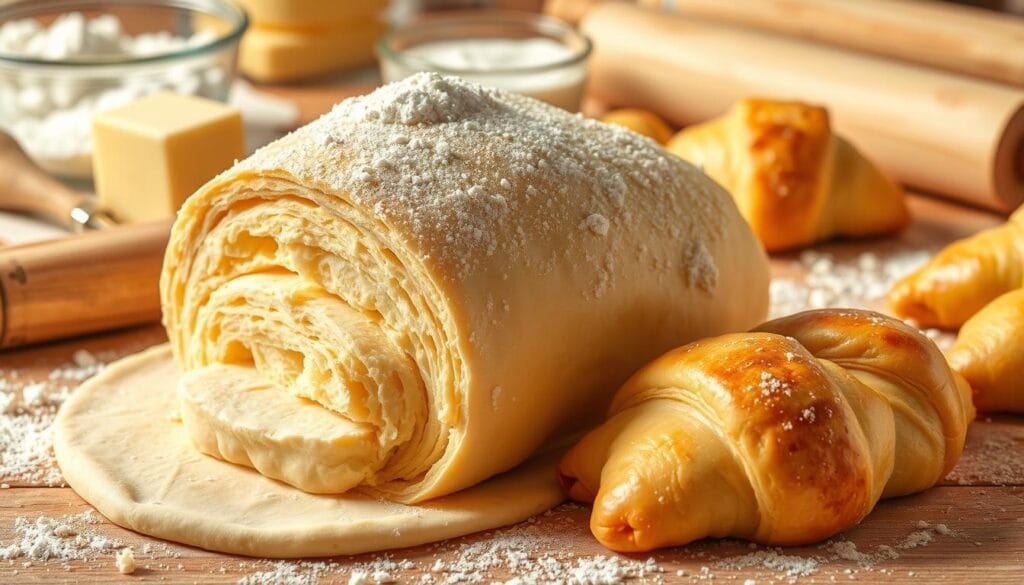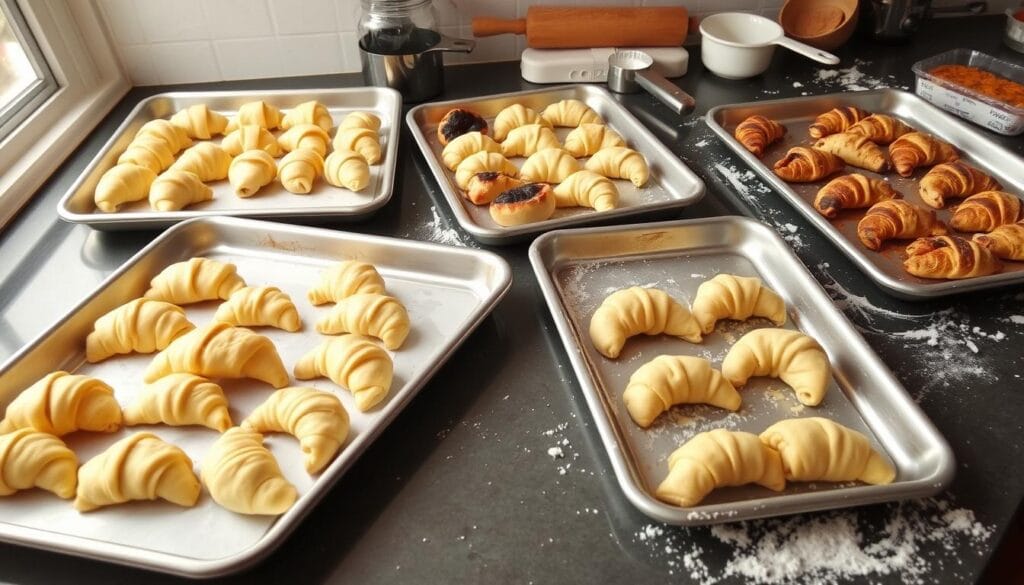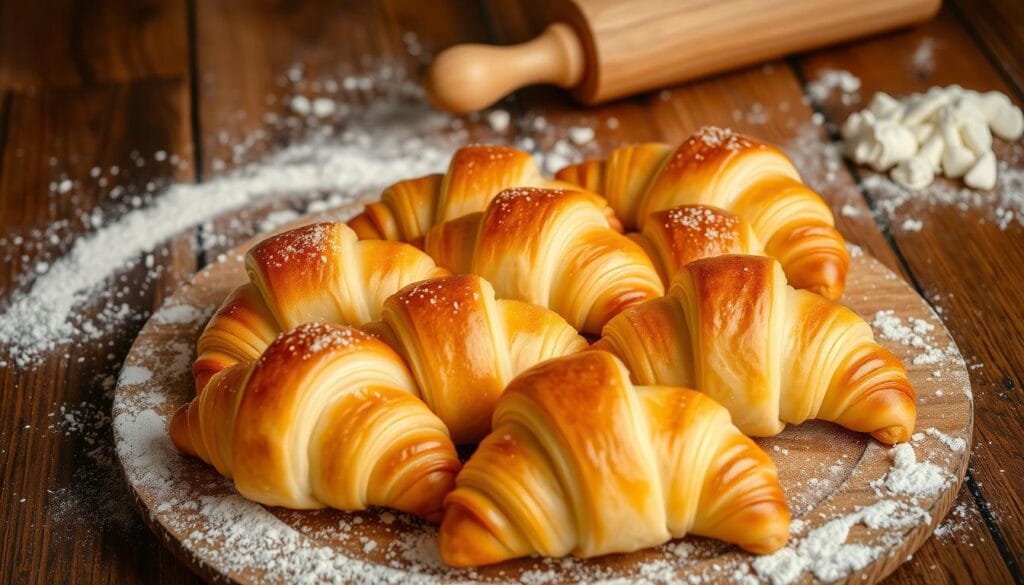Imagine waking up to the smell of freshly baked crescents. These flaky, buttery rolls are perfectly shaped. With patience and practice, you can make perfect crescents from scratch.
The process of making croissants takes at least 2 days. It involves about 4 hours of hands-on work and 4 stages. You’ll learn the importance of precise measurements, controlling dough temperature, and letting it rest. These steps are key to getting the perfect crescent shape.
This guide is for both beginners and experienced bakers. It covers making perfect crescents, from mixing the dough to baking the crescent rolls. You’ll discover the stages of making croissants, including lamination. You’ll need tools like a rolling pin, parchment paper, and a measuring tape.
You can make delicious, flaky crescents by following these steps and tips. They will impress your family and friends. And you’ll enjoy the perfect crescent shape in every bite.
Table of Contents
Understanding the History of Crescents in Culinary Arts
The crescent definition of cooking has been around for centuries. It has shaped how we enjoy pastries today. Like the crescent moon, the crescent shape symbolizes growth and renewal in many cultures.
Origins of Crescent-Shaped Pastries
Crescent-shaped pastries, like the croissant, come from ancient times. The crescent meaning is filled with symbolism and tradition. The kipper, an early croissant version, was first mentioned in 1227.
Cultural Significance Across Different Cuisines
The crescent shape means different things in various cultures. In Europe, it carries religious and historical meanings. For example, France named the croissant a national product in 1920, showing its cultural importance.
Spain’s Xuixo also shows the crescent’s role in different cuisines.
Evolution of Modern Crescent Rolls
Modern crescent rolls have changed a lot. The croissant was once a luxury introduced to France in 1839 by August Zang. Sara Lee’s frozen dough in 1981 made them easier to find.
Now, we see variations like the American croissan’wich. This shows how the crescent definition is growing worldwide.
| Year | Event |
|---|---|
| 1227 | Croissants believed to be created by Viennese bakers |
| 1683 | Croissant believed to be created by Viennese bakers |
| 1839 | Croissant named the national French product |
| 1915 | Sylvain Claudius Goy introduces lamination technique |
| 1920 | Croissant named national French product |
| 1981 | Sara Lee innovates frozen croissant dough |
Essential Tools and Equipment for Crescent Making
You need the right tools to make perfect crescent dough. Each tool plays a unique role in making your pastries light and flaky.
Digital Scale: Measuring ingredients precisely is key. A digital scale helps you use the exact amount of each ingredient. This is crucial for consistent crescent dough.
Stand Mixer: Mixing by hand can be slow and inconsistent. A stand mixer mixes ingredients smoothly. It prepares your crescent dough efficiently.
Rolling Pin: A good rolling pin is essential for dough thickness. The dough needs to be evenly thick for flaky layers in crescent dough.
Measuring Tape: Accurate measurements are essential. They ensure that your butter block matches the dough, vital for the dough folding process that creates layers in crescent dough.
Baking Tray and Parchment Paper: A sturdy baking tray is needed for even baking. Parchment paper prevents sticking and makes cleanup easy.
Plastic Wrap: Keeping your dough covered is crucial to prevent drying. Plastic wrap lets your crescent dough rest properly during chilling and rising.
Chef Knife: A sharp chef knife is needed to cut the dough into precise triangles. Cutting precisely ensures uniform baking.
Pastry Brush: A pastry brush is used for an egg wash. It gives your crescents a golden-brown finish and adds a sheen.
Having these tools will help you make delicious crescent dough. Each tool helps with texture and flavor, making your pastries taste like they came from a bakery.
| Tool | Purpose |
|---|---|
| Digital Scale | Ensures precise measurement of ingredients |
| Stand Mixer | Efficiently mixes and blends dough ingredients |
| Rolling Pin | It provides a stable surface for baking crescents |
| Measuring Tape | Measures dough and butter blocks accurately |
| Baking Tray | Provides a stable surface for baking crescents |
| Parchment Paper | Prevents dough from sticking to the baking tray |
| Plastic Wrap | Keeps dough covered during chilling and rising |
| Chef Knife | Cuts dough into precise triangles for crescent shaping |
| Pastry Brush | Applies egg wash for a golden finish |
Ingredients for Perfect Crescents
To make perfect crescents, focus on each ingredient’s quality and role. Choosing the right parts ensures your crescents look like they belong in nature.
Basic Dough Components
For the proper structure, begin with all-purpose flour. Mix it with water and whole milk for a smooth base. Salt adds flavor, and sugar down the ough and keeps it moist.
Instant yeast is key to making them light and airy. Cold European unsalted butter is vital for flaky layers. This recipe mirrors the dRecipee curves found in nature.
Optional Filling Ingredients
To make your crescents memorable, add different fillings. For sweet treats, try chocolate, almond paste, or fruit jams. For a savory twist, use cheese, ham, or spinach.
These fillings let you tailor your crescents for any event. They make your creations versatile and exciting.
Importance of Ingredient Temperature
It is crucial to keep ingredients at the right temperature. Cold butter creates distinct layers, and chilled dough prevents overheating. This careful control mirrors the balance in nature’s crescent shapes.
The Science Behind Crescent Dough
Understanding the science behind crescent dough is key to making perfect pastry. Laminated doughs, like croissants and Kipferl, need layers of dough and fat. European butter, with its high-fat content, is best for flakiness.
Gluten is crucial for dough structure. Using high-protein bread flour makes the dough firm and elastic, allowing it to stretch well during rolling. After mixing, resting the dough for about 30 minutes helps make it easier to work with.

- Fermentation: Developing flavor through controlled proofing until the dough doubles and feels springy.
- The Laminate Process involves three folds, which create layers of of butter and dough, which are used to create layers.
- Maillard Reaction: This is achieved by baking at 200°C (400°F), giving crescents their golden-brown color.
Temperature control is key. Keeping the dough cool prevents the butter from melting, ensuring distinct layers form during baking. The Maillard reaction also adds color and flavor.
Different fats change crescent texture and taste. A study showed that fat sources affect consumer liking and pastry quality. Baking conditions, like oven temperature and humidity, also impact the final product.
| Component | Amount per Croissant | Role in Dough |
|---|---|---|
| Bread Flour | 500g | Provides gluten for structure |
| European Butter | 250g | Creates flaky layers |
| Water | 150ml | Hydrates the dough |
| Milk | 150ml | Adds richness and flavor |
| Yeast | 10g | Facilitates fermentation |
| Sugar | 50g | Feeds the yeast and sweetens |
| Salt | 10g | Enhances flavor |
Preparing Your Workspace for Crescent Making
Creating an efficient workspace is key to making crescents. Drawing on crescent architecture, you can design your kitchen to use space effectively and improve workflow.
Surface Preparation
Begin by making sure your work surface is clean and big. A tidy area makes it easier to work with the dough and lowers the chance of contamination. Use a large countertop to fit all steps without feeling cramped.
Temperature Considerations
Keeping the right temperature is essential. Keep your kitchen cool to stop the dough from getting too sticky. Use air conditioning or fans to keep the temperature right, making the dough easy to work with.
Organization Tips
Organize your tools and ingredients smartly. To make baking smoother, put things you use frequently where you can easily reach them. Use storage ideas inspired by crescent architecture to help things flow better and reduce the need to move around.
| Workspace Setup Checklist | Details |
|---|---|
| Clean Work Surface | Ensure countertops are free from clutter and sanitized before starting. |
| Optimal Temperature | Maintain a cool kitchen environment around 65-70°F for ideal dough handling. |
| Accessible Tools | Arrange mixers, rolling pins, and other tools within arm’s reach. |
| Ingredient Organization | Store ingredients in labeled containers for quick access and efficiency. |
| Flow Optimization | Design the workspace layout to follow the natural steps of crescent making. |
Mastering the Basic Crescent Shape
Getting the perfect crescent shape is key to making professional-looking crescent rolls. Roll your dough to about ¼ inches thick on a lightly floured surface.
Then, use a sharp knife or pizza cutter to cut the dough into long, even triangles. Uniform triangles ensure that all crescent rolls bake evenly and look the same.
Shaping each crescent means rolling the dough from the base to the tip. This method creates a classic, curved shape that looks great and holds fillings well.
Common mistakes include uneven triangles and overworking the dough, which can mess up the shape. To avoid these problems:
- Use a ruler or guide to cut uniform triangles.
- Handle the dough gently to keep its texture.
- Practice the rolling technique for a smooth curve.

| Common Mistakes | How to Avoid |
|---|---|
| Uneven triangle sizes | Use a ruler or cutting guide for uniformity. |
| Overworking the dough | Handle gently to keep the dough soft and pliable. |
| Incorrect rolling technique | Roll consistently from base to tip for a smooth curve. |
Step-by-Step Rolling Technique
Learning to roll dough is key to making perfect crescents. Follow these steps to get flaky, well-shaped crescent dough.
Initial Dough Rolling
Roll the chilled dough into a 20×32 cm (8×12.5 inch) rectangle. Use a lightly floured surface. Roll it evenly with about 0.5 cm (1/4 inch) thickness. This role is essential for the dough’s layers.
Creating Perfect Triangles
Next, cut the dough into triangles with a base of about 8 inches. Use a sharp knife or pizza cutter. Make sure the cuts are straight for even baking.
Rolling the Final Shape
Now, roll each triangle from the base to the point. Use light pressure to keep the layers intact. This step shapes the crescents and makes them flaky.
| Step | Description | Measurements |
|---|---|---|
| 1. Initial Rolling | Roll dough into a rectangle | 20×32 cm (8×12.5 inch) with 0.5 cm thickness |
| 2. Cutting Triangles | Slice dough into uniform triangles | 8-inch base each |
| 3. Final Rolling | Roll from base to point gently | Maintain layers for flakiness |
Common Mistakes to Avoid When Making Crescents
Even experienced bakers can make mistakes when making crescent rolls. Knowing these common errors helps ensure your crescents are light and flaky every time.

- Overworking the Dough: Kneading too much can make the dough tough, preventing it from being airy.
- Incorrect Butter Incorporation: Too-warm butter disrupts laminating, leading to dense rolls.
- Improper Proofing Time: Not allowing enough time for the dough to rise can result in under-proofed crescents that don’t achieve the desired crescent shape.
- Incorrect Baking Temperature: Too low a temperature prevents the layers from puffing up properly.
- Using Stale Ingredients: Old yeast or flour can affect the dough’s ability to rise and develop the right texture.
To avoid these issues, ensure you:
- Keep ingredients cold, especially butter, during the laminating process.
- Allow the dough to rest in the refrigerator for at least 20 minutes between folds.
- Proof the dough until it doubles in size and feels soft and springy.
- Bake at a high temperature to help the layers expand beautifully.
- Use fresh, high-quality ingredients for the best results.
| Mistake | Solution |
|---|---|
| Overworking the Dough | Knead until just smooth and elastic to maintain lightness. |
| Incorrect Butter Temperature | Use cold butter to ensure proper laminating and flaky layers. |
| Insufficient Proofing | Allow the dough to rise until doubled in size for optimal texture. |
| Low Baking Temperature | Preheat the oven to a high temperature to achieve a perfect crescent shape. |
| Using Stale Ingredients | Always use fresh yeast and high-quality flour for the best results. |
Different Types of Crescents Around the World
Crescents have a rich history worldwide. Each culture adds its unique touch to these delicious pastries. Understanding the crescent’s meaning in different regions can deepen one’s appreciation for their craftsmanship and tradition.
French Croissants
The French croissant is perhaps the most renowned crescent-shaped pastry worldwide. It’s known for its flaky layers and buttery taste. The croissant symbolizes luxury and culinary excellence.
The crescent moon shape adds to its aesthetic appeal. It also ties back to historical crescent meanings of transformation and elegance.
Austrian Kipferl
The Austrian kipper is a traditional pastry that predates the croissant. It has a denser texture and a slightly sweet flavor, and it holdss cultural significance in Austria.
The crescent moon shape represents growth and prosperity. It aligns with the region’s agricultural heritage.
American Crescent Rolls
In the United States, crescent rolls are a popular convenience pastry. They are versatile, easy to make, and often used in various recipeses. Thcrescent’snt meaning here leans towards adaptability and everyday enjoyment.
They make them a staple in American households.
| Type | Origin | Flavor Profile | Crescent Meaning |
|---|---|---|---|
| French Croissants | France | Buttery, flaky | Elegance, transformation |
| Austrian Kipferl | Austria | Dense, slightly sweet | Growth, prosperity |
| American Crescent Rolls | United States | Versatile, mild | Adaptability, daily enjoyment |
Sweet Filling Variations for Crescents
Crescent rolls are perfect for sweet fillings. They add a buttery taste and keep their crescent shape. Choose your favorite from chocolate, fruit preserves, or nut pastes.

Most crescent roll recipes use sweet fillings, with 70% using chocolate. Chocolate is a top pick, making up 45% of recipes. Fruit and nut pastes are also popular, with 30% and 25% increases in yearlyome. Recipescipes even mix different sweet fillings, offering a variety of tastes in each crescent.
- Chocolate Fillings: Perfect for those who love a decadent, sweet treat.
- Fruit Preserves: Add a tangy contrast to the buttery dough.
- Nut Pastes: Enhance texture and flavor with almond or hazelnut spreads.
Try this lemon cheesecake filling Recipe:
| Ingredient | Amount |
|---|---|
| Refrigerated crescent rolls | 1 package (8 count) |
| Regular plain cream cheese | 4 ounces |
| Granulated sugar | 2 tablespoons |
| Lemon extract | 1/4 teaspoon |
| Powdered sugar (glaze) | 1 cup |
| Lemon juice (glaze) | 1 1/2 tablespoons |
| Lemon zest (glaze) | Zest from half a lemon |
Nutritional information per serving:
| Nutrient | Amount |
|---|---|
| Calories | 132 |
| Carbohydrates | 20g |
| Protein | 1g |
| Fat | 6g |
| Saturated Fat | 3g |
| Cholesterol | 16mg |
| Sodium | 60mg |
| Sugar | 18g |
Savory Crescent Recipes and Applications
Crescents aren’t just for sweet treats—they’re great for savory fillings, too. In baking, the use of crescent rolls for savory recipes has increased by 67%. These versatile pastries are now a top choice for many.
Looking for appetizers, lunches, or light dinners? Crescent rolls are perfect. They can be filled with a variety of tasty ingredients. Here are some favorites:
Cheese-Filled Options
- Cheddar and Herb: A mix of sharp cheddar and fresh herbs.
- Spinach and Feta: A classic combo with a Mediterranean twist.
Meat-Based Fillings
- Turkey Lattice Pie: Great for a hearty meal.
- Champion Chicken Puffs: Savory and satisfying for any time.
Vegetarian Alternatives
- Mushroom Asparagus Quiche: A delightful mix of flavors.
- Party Pesto Pinwheels: Fresh and aromatic for a light option.
Adding savory crescent rolls to your meals adds variety and is quick and tasty. Here’s a table with some popular savory crescent recipes, their prep time, and calorie count:
| Recipe | Total Time | Calories per Serving |
|---|---|---|
| Cinnamon Crescent Twists | 20 mins | 96 |
| Turkey Lattice Pie | 40 mins | N/A |
| Party Pesto Pinwheels | 30 mins | 76 |
| Mushroom Asparagus Quiche | 45 mins | 272 |
| Italian Brunch Torte | 110 mins | 480 |
| Cinnamon Tea Rolls | 20 mins | 144 |
| Macaroon Bars | 40 mins | 103 |
| Pizza Pinwheels | 30 mins | 118 |
| Apple Dumplings with Crescent Rolls | 50 mins | 414 |
| Burrito Bake | 55 mins | N/A |
| Pinwheel Steak Potpie | 45 mins | N/A |
| Turkey Bundles | 30 mins | N/A |
Storing and Reheating Your Crescents
It’s essential to store and reheat crescent rolls properly to keep them fresh. Whether you enjoy them today or save them for later, these tips help ensure that they are delicious and flaky.
Proper Storage Methods
Let your crescent rolls cool completely after baking. For a short time, store them in an airtight container at room temperature for up to two days. For more extended storage, freeze them. Wrap each roll in plastic wrap and then in a freezer-safe bag. This keeps them fresh for up to two months.
- Short-Term: Airtight container at room temperature
- Long-Term: Wrapped tightly and frozen
Reheating Techniques
Reheating your crescent rolls right keeps them flaky and soft. Here are the best ways:
| Method | Equipment | Time | Rating |
|---|---|---|---|
| Microwave | Toshiba, Panasonic | 30-60 seconds | 5/10 |
| Oven | GE, Samsung | 5-10 minutes at 300°F | 8/10 |
| Air Fryer | Cosori, Ninja | 3-5 minutes at 300°F | 5/10 |
| Toaster Oven | Breville, Cuisinart | 5-7 minutes at 325°F | 7/10 |
To keep the crescent rolls moist and crispy, it’s best to use an oven. Microwaving can cause them to lose texture. For the best results, preheat your oven and watch the reheating closely. This way, you’ll get perfect crescent rolls every time.
Troubleshooting Common Crescent Problems
You might face challenges when perfecting the crescent shape, even with careful preparation. Understanding the crescent definition helps identify and solve these issues.
- Dough Too Warm: It won’t hold the crescent shape if your dough becomes too soft. Keep your ingredients chilled and work in a calm environment to maintain consistency.
- Insufficient Proofing: Under-proofed dough can cause crescents not to rise properly. Ensure you allow adequate time for the dough to rise until it doubles in size.
- Improper Shaping: Uneven shaping can cause crescents to bake unevenly. Roll the dough to a consistent thickness and follow precise folding techniques to maintain the classic crescent definition.
- Uneven Browning occurs when crescents are not positioned correctly in the oven. Rotate your baking sheet halfway through the baking time to ensure even color and texture.
Addressing these common problems will help you consistently achieve the perfect crescent shape. Pay attention to ingredient temperatures, proofing times, and shaping techniques to enhance your crescent definition and overall quality.
Making Ahead and Freezing Tips
Preparing crescent rolls ahead of time can save you a lot of time and ensure you always have fresh pastries ready. Whether you freeze the crescent dough or the baked rolls, the proper steps keep them excellent.

Freezing Raw Dough
To freeze the crescent dough, just follow these steps:
- Shape the dough into rolls.
- Wrap each roll tightly in plastic wrap.
- Place the wrapped rolls in a freezer bag, removing as much air as possible.
Mark the bag with the date and freeze for 2-3 months. Don’t freeze dough that’s already proofed to avoid texture problems.
Freezing Baked Crescents
Baked crescent rolls can also be frozen for later:
- Let the crescent rolls cool completely.
- Wrap them individually in plastic wrap or put them in a freezer-safe container.
- Store in the freezer for up to 2-3 months.
Using pre-cooked fillings keeps the flavor consistent after freezing.
Thawing Instructions
Ready to enjoy your frozen crescent rolls? Here’s how to thaw them:
- For raw dough, thaw in the fridge overnight or at room temperature for 2 hours before baking.
- Thaw at room temperature for no more than 2 hours for baked rolls.
After thawing, warm the crescent rolls in a 350°F oven for 5-7 minutes. This makes them crispy again. Don’t thaw in the microwave to avoid them getting soggy.
Serving Suggestions and Presentation Ideas
Serve your crescents thoughtfully to improve your dining experience. Whether you’re hosting a cozy breakfast or a big dinner party, how you present matters extensively. It will impress your guests.
Place your crescents on a platter that matches their shape. Use different sizes and angles to catch the eye. Try crescent architecture for a more elaborate display, stacking crescents in arcs, like in fancy buildings.
Match your crescents with dishes and drinks that complement each other. For breakfast, pair them with fresh fruit and coffee or tea. At dinner, serve them with salads, soups, or white wine.
- Casual Breakfast: Crescent rolls with butter, jam, and scrambled eggs.
- Elegant Dinner: Cheese-filled crescents with mixed greens and herbal cocktails.
- Appetizers: Mini meat or veggie crescents with dipping sauces.
Decorate your plates with fresh herbs or some sauce for a good look. Choose plates that show off the crescent shape. It makes your presentation look better.
| Occasion | Complementary Dishes | Beverage Pairings |
|---|---|---|
| Breakfast | Fresh fruit, scrambled eggs | Coffee, herbal tea |
| Brunch | Salads, smoked salmon | Mimosas, iced tea |
| Dinner Party | Mixed greens, soup | White wine, sparkling water |
| Appetizers | Mini meat crescents, veggie dips | Cocktails, sparkling juice |
Conclusion: Mastering the Art of Crescent Making
Making perfect crescents is both an art and a science. You learn about the history of crescent rolls and the techniques needed. Every step helps you get better at baking.
The right mix of ingredients and how you handle the dough are key. This ensures that your crescents look tremendous and taste amazing, becoming as beautiful as the crescent moon.
This guide has given you the skills to try different fillings and flavors. You can make sweet or savory crescents. They’re perfect for any event and will make everyone happy.
Keep practicing, and you’ll love making each crescent roll. You can mix old recipes with your ideas. Let the beauty of the crescent moon inspire your baking.
With hard work and creativity, you’ll become great at making crescents. They will add warmth and joy to anRecipe
FAQ
What is the difference between crescent rolls and croissants?
What essential tools do I need to make crescent rolls at home?
How can I achieve the perfect crescent shape for my rolls?
What impact does ingredient temperature have on crescent dough?
Can I customize the fillings in my crescent rolls?
How should I store homemade crescent rolls to keep them fresh?
What is the cultural significance of crescent-shaped pastries?
What are some common mistakes to avoid when making crescent rolls?
Can I make crescent dough ahead of time and freeze it?
What different types of crescents are enjoyed around the world?
Have you tried our Recipe ?
There are no reviews yet. Be the first one to write one.

